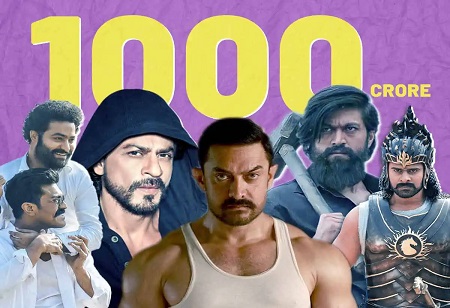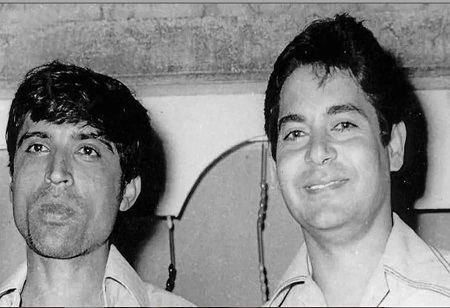Films Before Figures: The Most Beautiful Perspective
The post-COVID era has brought several shifts in the film industry—many of them positive—but one of the more unfortunate trends to emerge is the growing obsession with box office numbers. Conversations today seem to revolve less around the quality of a film and more around how much it earned. Fans now eagerly pit their favorite superstars against each other, using box office collections as the ultimate measure of success.
Of course, commercial performance is a critical part of filmmaking—it sustains the industry—but is that all a film should be judged by? Does a ₹500-600 crore collection automatically mean the film is good? Has cinema been reduced to a numbers game? It’s important to pause and reflect on these questions and dig a little deeper into what truly defines a film's worth.
The Box Office Obsession
Over the past five years, the term “Pan-India” has become one of the most dominant buzzwords in Indian cinema. A select few films have successfully broken through their regional markets to captivate audiences across the nation. What initially appeared to be a blessing now seems, in some ways, to have become a double-edged sword.
S. S. Rajamouli’s Baahubali: The Beginning and Baahubali 2: The Conclusion were the trailblazers of this Pan-India wave. These films didn’t just bring together stars from different industries; they marked the beginning of grand multi-starrer projects that united North and South Indian cinema on an unprecedented scale. Baahubali: The Beginning grossed over ₹650 crore worldwide, while its sequel, Baahubali 2: The Conclusion, went on to earn a staggering ₹1788 crore globally, becoming the highest-grossing Indian film at the time, just behind Dangal. Together, the franchise amassed over ₹2460 crore worldwide.
While Dangal might have topped the charts in terms of revenue, the cultural and cinematic impact of Baahubali was unmatched. It reshaped the business landscape, encouraging cross-industry collaborations and fostering a sense of unity among the various film industries in India. Audiences began  exploring the previous works of the actors, directors, and technicians involved, fueling a new appetite for films beyond linguistic and regional boundaries. This momentum gave rise to an era where stars from all corners of the country joined forces to create Pan-India spectacles.
exploring the previous works of the actors, directors, and technicians involved, fueling a new appetite for films beyond linguistic and regional boundaries. This momentum gave rise to an era where stars from all corners of the country joined forces to create Pan-India spectacles.
With these collaborations, the scale of productions, budgets, and expectations skyrocketed. Audiences now crave grander worlds, bigger visuals, and fresh cinematic experiences. However, along with this rise came an intense obsession with box office numbers. Conversations around films increasingly revolve around how much they collected on opening day, in their first weekend, or whether they joined the ₹100, ₹500, or ₹1,000 crore club.
While commercial success is vital, it’s concerning that the artistic merit of a film is often reduced to its financial performance. Success is increasingly measured by the hundreds of crores a film collects, often overshadowing the artistic value of the story itself. In many ways, cinema is turning into a numbers game, where the conversation focuses more on financial milestones than on storytelling, performances, or craft. This obsession risks pushing filmmakers to chase scale over substance, potentially leaving original, meaningful narratives behind.
“STOP JUDGING FILMS BY B-O NUMBERS. Terrible films sometimes make a lot of money and good films make less money. Focus on your experience of the film as an audience and not on the film’s collections. Focus on whether the film was worth the price of your ticket not on whether the price of the film star should go up or down.” – Hansal Mehta (director of Aligarh, Faraaz)
The Thirst for a 1000 Crore Film
 Every industry goes through distinct phases. For instance, when a period film like Baahubali achieves massive success, it often sparks a wave of similar films in that genre. But does this formula always work? Certainly not. While these tentpole films generate significant revenue and draw massive attention, they also come with their own set of drawbacks.
Every industry goes through distinct phases. For instance, when a period film like Baahubali achieves massive success, it often sparks a wave of similar films in that genre. But does this formula always work? Certainly not. While these tentpole films generate significant revenue and draw massive attention, they also come with their own set of drawbacks.
In today’s landscape, almost every filmmaker aspires to create a “pan-India” film. To appeal to audiences across states, producers and directors frequently cast top actors from different regional industries. But is assembling a multi-star cast enough to guarantee success? Again, not really.
There’s also a growing obsession with scale. When big stars are involved, the expectations naturally escalate. Filmmakers aim to build grand worlds, deliver dazzling visuals, and offer cutting-edge VFX and CGI to create larger-than-life spectacles. But is this spectacle alone enough? Clearly, it’s not.
What truly makes a film work is the story. No matter how many stars you bring in or how visually stunning your film is, without a compelling narrative, it simply won’t resonate. In recent years, only a few films like RRR, Kantara, Pushpa, and KGF have successfully struck the right balance — blending scale with strong storytelling.
Most Rooted is the Most International
Only a handful of films manage to truly break barriers and resonate with audiences across the country. But why does this happen? Interestingly, most of these films weren’t even designed to appeal to a pan-India audience. They were created with a local audience in mind, focusing on their home state and culture — and that’s exactly why they worked. Without the pressure to cater to everyone, these films remained authentic. There were no forced cameos, no star-studded casts from multiple industries, no extravagant budgets — just honest, well-crafted storytelling.
A recent example is the Malayalam film Manjummel Boys, based on a true story about a group of friends from Kerala who go on a trip to Ooty, where one of them accidentally falls into a pit. The film’s powerful writing and emotional depth made it a nationwide success. Similarly, the Kannada film Kantara, made on a modest budget of ₹20 crores, was rooted in local folklore from Mangalore, Karnataka. It didn’t rely on big stars or grand visuals, yet it struck a chord across India by collecting over ₹400 crores.
“Only 1 percent succeed [in chasing Rs 800–900–1,000 crore], yet everybody is chasing the same. It leads to inflated budgets and compromises on storytelling.” – Anurag Kashyap (director, Gangs of Wasseypur)
Why do films like these succeed? Because at their core, they tap into universal emotions. They are deeply rooted, culturally specific stories that still manage to connect with everyone. Filmmakers and producers need to realize the immense value in telling such grounded stories. India’s folklore is vast and rich — just think of the countless narratives waiting to be discovered in each state. Telling these stories not only preserves cultural heritage but also offers fresh, unique cinematic experiences for audiences nationwide. For this movement to grow, it’s essential to give writers their due importance. They are the ones who can unearth these hidden gems and bring them to life.
Bring Back the Writers!
There used to be a time where films sold because they were written by legendary writers such as Salim Khan, Javed Akhtar, Mrinal Sen, M.T. Vasudevan Nair, Khwaja Ahmad Abbas, and K Balachandar. Today, we do not see the writer’s name anywhere. A film can have the greatest of landscapes, the best of actors, and mighty large sets but none of this will have an impact if your story does not work. We need to invest significantly in writers and return to an era where their importance is truly recognized, so that original content can make a strong comeback.
One of the most critical aspects the Indian film industry lacks is giving credits to the writer. Unlike writers across Europe and America, the writers here are not given equal importance as directors. This is a major concern as writers are often forced to become directors just to get the recognition they deserve. We see title cards for actors, producers, and directors, but not for writers. This should change. The whole idea of writer and director should change as in India it is seen as a single profession. It is high time people realize that it is not — just because a person can direct does not mean he/she can write and vice versa.
“Writers are one of the most important factors in the process of making a film, if not the most important. People become directors because there is no money or due recognition in being a writer, which may not be the right reason to become a director.” – Aakash Kaushik (Screenplay writer, Housefull 4, A Flying Jatt, F.A.L.T.U, Thank God)
Another major issue is the payment. Writers should be respected and paid on time for their work. A survey by Ormax and Tulsea found that 63% of Indian screenwriters are dissatisfied with their pay and 53% with the credit they are given for their work.
Unless you have a great story with decisive writing and emotions intact, no matter what else you do, the film won’t click. Even if half the amount invested in the stars and the look of the film is spent on writers, we can witness beautiful and diverse stories on screen. Filmmakers must realize that focusing on authentic, regional storytelling can create universal resonance. India, with its rich folklore and diverse cultures, offers an untapped reservoir of unique stories that can redefine the cinematic landscape.
OTT: Boon and Bane
The post-pandemic surge of OTT platforms like Netflix, Amazon Prime Video, Disney+ Hotstar, and JioCinema has permanently altered viewing habits. The Indian OTT market is expected to reach $13–15 billion by 2030, growing at a CAGR of over 20%, according to a report by PwC. Today, people in villages are watching big-budget Hollywood films, while urban viewers are exploring deeply rooted regional dramas. The widespread availability of diverse content in multiple local languages has been a game-changer, enabling filmmakers to showcase their work to broader, more varied audiences. This shift has significantly raised the bar for content quality and viewer expectations, accelerating the evolution of the film industry.
However, this growth comes with its own set of challenges. OTT platforms, much like friction, are a necessary force — essential, yet not without drawbacks. Many films now strike deals that bring them to streaming platforms just weeks after their theatrical release. As a result, general audiences often choose to wait, heading to theatres only if a film receives overwhelmingly positive reviews or launches during major festivals. This has led to a notable decline in theatre footfalls, particularly hurting small films. These smaller projects may offer exceptional stories but often struggle to get the recognition they deserve on the big screen.
Films like Kumbalangi Nights, The Great Indian Kitchen, Laapataa Ladies, 12th Fail, and Manamey found nationwide acclaim largely through their OTT releases, although were ignored when they released on big screens. Fortunately, OTT platforms at least provide them a second life, allowing such films to eventually find an audience — though it would be far better if they were celebrated right from their theatrical release.
Also Read: OTT Platforms Devise Fresh Strategies to Reduce Costs
What the Industry Needs
- Recognition and fair pay for writers: Writers must be credited and compensated fairly. Without strong writing, no scale or star power can save a film.
- Return to authentic storytelling: Rooted, culturally specific stories have proven to resonate with wider audiences. India’s folk tales, local histories, and regional narratives are a goldmine waiting to be explored. Bollywood is in desperate need of this compared to the other Indian industries.
- Balanced approach to OTT and theatrical releases: While OTT platforms have expanded viewership, the industry must find ways to sustain theatrical viability, especially for mid-budget and indie films.
A film earning 100 crores doesn’t automatically make it a good film, just as a film with modest collections isn’t necessarily bad. I truly hope small films receive their due recognition at the right time, and that writers once again become the heart of cinema. Films aren’t just about grand sets, big stars, or massive scale — they’re about the story, the passion, the narrative, and the emotions they evoke. Writers shouldn't create with the pressure to please everyone, but rather aim to genuinely move someone — even if it's just one person, because someday, somewhere, someone will speak about your film, whether it’s in a small tea shop or a five-star hotel.
🍪 Do you like Cookies?
We use cookies to ensure you get the best experience on our website. Read more...






